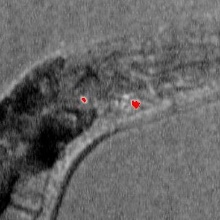Microplastics effects on reproduction and body length of the soil- dwelling nematode Caenorhabditis elegans.
Schöpfer et al. 2020 Frontiers in Environmental Science
Microplastics (MP) are pervasive in the environment. There is ample evidence of negative MP effects on biota in aquatic ecosystems, though little is known about MP effects in terrestrial ecosystems. Given numerous entry routes into soils, soil organisms are likely to be exposed to MP.
In collaboration with colleagues of the Institute of Soil Science and Land Evaluation, University of Hohenheim, we compared potential toxicological effects of MP from (i) low-density polyethylene (LDPE) (mean diameter ± standard deviation: 57 ± 40 μm) or (ii) a blend of biodegradable polymers polylactide (PLA) and poly(butylene adipate-co-terephthalate) (PBAT) (40 ± 31 μm) on the reproduction and body length of the soil-dwelling bacterivorous nematode Caenorhabditis elegans. Feed suspensions without (control) or with MP (treatments) at concentrations of 1, 10, and 100 mg MP/L were prepared and nematodes were exposed to those suspensions on NGM agar plates until completion of their reproductive phase (~ 6 days).
Using Nile red-stained PLA/PBAT MP particles and fluorescence microscopy, we demonstrated the ingestion of MP by C. elegans into pharynges and intestines. Under MP exposure, nematodes had fewer offspring (up to 22.9%) compared to nematodes in the control group. This decline was independent on the plastic type. We detected a tendency towards greater decreases in offspring at higher concentrations. Despite hints of negative effects on nematode body length under MP exposure, we could not derive a consistent pattern. We conclude that in MP-contaminated soils, the reproduction of nematodes, central actors in the soil food web, can be affected, with potentially negative implications for key soil functions, e.g., the regulation of soil biogeochemical cycles.
The research was recently published in the journal Frontiers in Environmental Science and is part of the project MiKoBo (Mikrokunststoffe in Komposten und Gärprodukten aus Bioabfallverwertungsanlagen und deren Eintrag in Böden – Erfassen, Bewerten, Vermeiden) which is funded by the Ministry of Environment, Climate and Energy Baden-Württemberg in the framework of BWPLUS – Baden- Württemberg Programm Lebensgrundlage Umwelt und ihre Sicherung (reference number: BWMK18003).
Paper:
Lion Schöpfer, Ralph Menzel, Uwe Schnepf, Liliane Ruess, Sven Marhan, Franz Brümmer, Holger Pagel & Ellen Kandeler (2020): Microplastics Effects on Reproduction and Body Length of the Soil- Dwelling Nematode Caenorhabditis Elegans. Frontiers in Environmental Science. https://doi.org/10.3389/fenvs.2020.00041. https://www.frontiersin.org/articles/10.3389/fenvs.2020.00041/full
Contact:
https://www.researchgate.net/profile/Lion_Schoepfer
https://bodenbiologie.uni-hohenheim.de/
Research Unit Biodiversity and Scientific Diving, Institute of Biomaterials and biomolecular Systems, University of Stuttgart, Pfaffenwaldring 57, D-70569 Stuttgart, Germany


